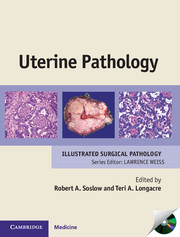Book contents
- Frontmatter
- Contents
- List of contributors
- Preface
- Acknowledgments
- 1 Cytology of the uterine cervix and corpus
- 2 Cervix: squamous cell carcinoma and precursors
- 3 Cervix: adenocarcinoma and precursors, including variants
- 4 Miscellaneous cervical abnormalities
- 5 Non-neoplastic endometrium
- 6 Endometrial carcinoma precursors: hyperplasia and endometrial intraepithelial neoplasia
- 7 Endometrioid adenocarcinoma
- 8 Serous adenocarcinoma
- 9 Clear cell adenocarcinoma and other uterine corpus carcinomas, including unusual variants
- 10 Carcinosarcoma
- 11 Adenofibroma and adenosarcoma
- 12 Uterine smooth muscle tumors
- 13 Endometrial stromal tumors
- 14 Other uterine mesenchymal tumors
- 15 Miscellaneous primary uterine tumors
- 16 Uterine metastases: cervix and corpus
- 17 Gestational trophoblastic disease
- 18 Other pregnancy-related abnormalities
- 19 Lynch syndrome (hereditary non-polyposis colorectal cancer syndrome)
- 20 Cytology of peritoneum and abdominal washings
- Index
- References
9 - Clear cell adenocarcinoma and other uterine corpus carcinomas, including unusual variants
Published online by Cambridge University Press: 05 July 2013
- Frontmatter
- Contents
- List of contributors
- Preface
- Acknowledgments
- 1 Cytology of the uterine cervix and corpus
- 2 Cervix: squamous cell carcinoma and precursors
- 3 Cervix: adenocarcinoma and precursors, including variants
- 4 Miscellaneous cervical abnormalities
- 5 Non-neoplastic endometrium
- 6 Endometrial carcinoma precursors: hyperplasia and endometrial intraepithelial neoplasia
- 7 Endometrioid adenocarcinoma
- 8 Serous adenocarcinoma
- 9 Clear cell adenocarcinoma and other uterine corpus carcinomas, including unusual variants
- 10 Carcinosarcoma
- 11 Adenofibroma and adenosarcoma
- 12 Uterine smooth muscle tumors
- 13 Endometrial stromal tumors
- 14 Other uterine mesenchymal tumors
- 15 Miscellaneous primary uterine tumors
- 16 Uterine metastases: cervix and corpus
- 17 Gestational trophoblastic disease
- 18 Other pregnancy-related abnormalities
- 19 Lynch syndrome (hereditary non-polyposis colorectal cancer syndrome)
- 20 Cytology of peritoneum and abdominal washings
- Index
- References
Summary
INTRODUCTION
Although endometrioid and serous adenocarcinomas comprise the majority of uterine corpus carcinomas, the less common clear cell, mucinous, and very rare squamous variants may pose considerable diagnostic problems. In addition, there are a variety of unusual carcinomas that occur in the uterus, some of which demonstrate distinctive clinical behavior as well as distinctive morphology. In contrast to the more common endometrioid and serous tumors, there are fewer data concerning these tumors.
CLEAR CELL CARCINOMA
Clear cell carcinoma currently accounts for less than 5% of all endometrial carcinomas in the United States.
Clinical characteristics
Clear cell carcinoma is considered to be a type II estrogen-independent nonendometrioid carcinoma. Patients tend to be older than those with endometrioid carcinoma, but slightly younger than those with serous carcinoma, with a mean age of 62 to 67 years. As with serous carcinoma, African-American women are more frequently affected. Despite its high grade, disease is confined to the uterus at presentation in 70% of patients. Radiation and tamoxifen have been implicated in a subset of clear cell carcinomas.
Clear cell carcinoma has a worse prognosis than endometrioid carcinoma. The five-year overall survival rate is 62.5% for patients with clear cell adenocarcinoma compared with 83.2% for those with endometrioid carcinoma. Stage is the most important prognostic factor; in the M. D. Anderson Center study, patients with low-stage (FIGO I and II) clear cell carcinoma had an estimated survival rate similar to that of patients with FIGO grade 3 endometrioid adenocarcinoma, and better than that of patients with serous carcinoma of similar stages.
- Type
- Chapter
- Information
- Uterine Pathology , pp. 174 - 195Publisher: Cambridge University PressPrint publication year: 2012



